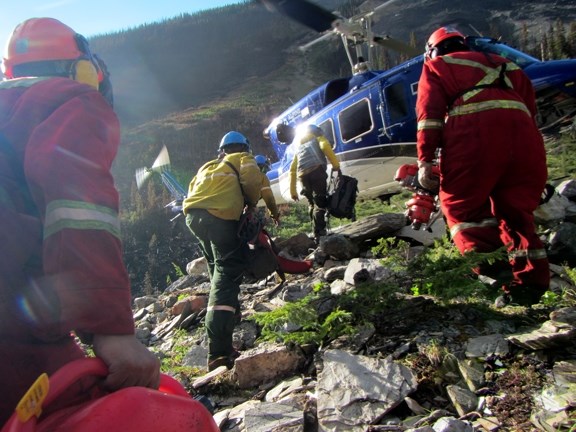As crews continue to battle the out-of-control Verdant Creek wildfire in Kootenay National Park, several campers have been charged for lighting illegal campfires during a critical fire ban.
As crews continue to battle the out-of-control Verdant Creek wildfire in Kootenay National Park, several campers have been charged for lighting illegal campfires during a critical fire ban.
Parks Canada's law enforcement branch has laid four charges and handed out six formal warnings for illegal campfires, both in the front country and backcountry, since a fire ban went into effect on July 18 due to extreme conditions.
“We've got enough on our plate with the lightning and the existing fire on the landscape,” said Jane Park, deputy incident commander for the Verdant Creek wildfire. “We don't want more to deal with.”
Fire management specialists are confident the 4,100-hectare fire is not a risk to local communities, noting the fire should soon be contained in key areas where there was potential for it to spread to the Bow Valley.
Park said there have been several crews directly fighting the leading edge of the fire and putting in containment lines, with a big focus on the Simpson Valley and Verdant Creek area.
“We've had crews working those lines and we're confident those lines are holding, and that there is no threat to adjacent communities at this time,” she said.
“They're not fully contained at the moment, but we should be at the point where we can say those areas are contained, hopefully within the next day or two.”
Lighting sparked the Verdant Creek fire, which was discovered July 15 at about 1,800 metres in elevation. With 70 km/h winds and hot, dry conditions, it rapidly spread in the coming days, including into neighbouring Assiniboine Provincial Park.
The fire remains on the B.C. side of the Continental Divide. As the crow flies, the fire is about 24 kilometres from the Town of Banff, 29 kilometres from Harvie Heights, and 31 kilometres from Canmore.
Last week brought six to seven millimetres of rain to the area, which did help firefighting efforts.
“That did give us some time for the crews to make some really good progress, so it has bought us some time,” Park said.
“The other part of that picture is that not everywhere in the park got that similar amount of rain, so we are still trying to maintain our preparedness for new fire starts elsewhere.”
With an impressive thunderstorm Sunday night (July 23), Parks Canada increased its smoke patrols the following day.
“There's no new starts that we know of and we will be sending crews out to do some additional smoke patrols,” said Park.
“The park did receive a fair bit of lightning, with again variable precipitation. We remain ready for that.”
The Verdant Creek warden cabin was destroyed in the fire when it moved quickly due to 70 km/h winds on July 16.
“It's a patrol cabin but it hasn't been used extensively because it's quite remote,” said Park, noting it was built about 60 years ago.
Given the progress made on the northern flank of the fire, Parks Canada was confident to open up several areas Monday, including Sunshine Village, its gondola, Standish chairlift and viewpoint.
The Brewster Creek area is now open, except for Fatigue Creek Trail and Citadel Pass Trail area. Backcountry closures are still in place in the Verdant Creek area of Kootenay. In Banff National Park, the Egypt Lake and Fatigue Pass areas remain closed.
Approximately 75 people are working the fire, and five helicopters are involved in the operation.
